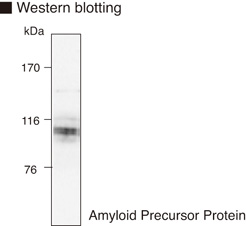Anti-Amyloid Precursor Protein (Human/Mouse) mAb
| Code | Size | Price |
|---|
| MBL-M009-3 | 100 ug | £323.00 |
Quantity:
Prices exclude any Taxes / VAT
Overview
Host Type: Mouse
Antibody Isotype: IgG1
Antibody Clonality: Monoclonal
Antibody Clone: 3E9
Regulatory Status: RUO
Target Species:
- Human
- Mouse
Application: Western Blot (WB)
Shipping:
4°C
Storage:
4°C
Images
Documents
Further Information
Applications:
WB - 5-10 ug/mL (chemiluminescence detection system)
Background:
Alzheimer's disease (AD) is the most common form of dementia in the elderly. The neuropathological hallmarks are neurofibrillary tangles and senile plaques. The major protein component of the plaques consists of 39-42 amino acids peptide (b-amyloid/Ab). Ab occurs in two predominant forms with different COOH-termini, Ab 40 and Ab 42, and overproduction of Ab 42 has been suggested to be the cause of familial earlyonset AD. Ab generation depends on proteolytic cleavage of the amyloid precursor protein (APP) by two proteases: b-secretase and g-secretase. Recent study suggested that a transmembrane aspartic protease, termed b-site APP-cleaving enzyme (BACE), functionally acts as the b-secretase.
Formulation:
This antibody is lyophilized form. Prepare a stock solution by dissolving the lyophilized antibody in 100 mL of distilled water. After reconstitution, the IgG concentration should be 1 mg/mL in PBS (pH 7.2)/1% sucrose, 0.09% NaN3.
Gene IDs:
Human: 351 Mouse: 11820
Immunogen Translated:
APP695 synthetic peptides (18-38 aa) (LEVPTDGNAGLLAEPQIAMFC)
Reactivity:
This antibody reacts with Amyloid Precursor Protein on Western blotting
Source:
This antibody was purified from mouse ascites fluid using protein A agarose. This hybridoma (clone 3E9) was established by fusion of mouse myeloma cell SP2/0-Ag14 with Balb/c mouse splenocyte immunized with the synthetic peptide, LEVPTDGNAGLLAEPQIAMFC, which corresponding to APP695 (18-38 aa).
Target:
Amyloid Precursor
References
1) Gylys, K. H., et al., Am. J. Pathol. 165, 1809-1817 (2004)
2) Golde, T., et al., Science 255, 728-730 (1992)
3) Selkoe, D. J., et al., Cell 58, 611-612 (1989)
4) Kang, H., et al., Nature 325, 733-736 (1987)




